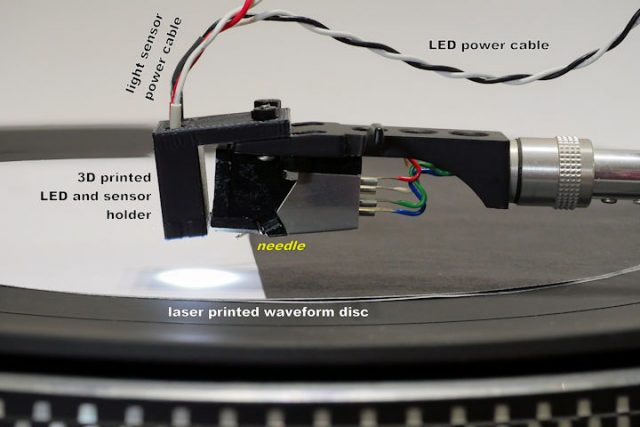This video, via Robot Room, demonstrates how you can make a mechanical waveform generator from an old turntable, a simple light sensor circuit and some laser-printed disks.

A white LED provides a consistent bright light source that reflects off the printed waveform disc into the light sensor. When a dark portion of the disc rotates underneath the light sensor, less light is reflected, and thus the voltage is lower on the output.
See the Robot Room site for more details.
Check it out and let us know what you think of it in the comments!

Was fun to see a different way of visualizing waveforms.
This way of thinking directly applies to spectral synthesis as well.
What happens if you try to scratch with it?
You would create a waveform based on the shaded area you are moving past the light sensor. If it was on the edge of pure black and white sections you would create a square wave with varying frequency.
The problem with this is that photo resistors typically have a lag of several milliseconds, so as you get up into the audio range your waveforms will lose definition. I doubt you’d be able to produce audio waves much higher than about 1 kHz.
Rather than a photo resistor, use a photodiode. Typical rise time is 10 -30 nSec. when you reverse bias it.
it’s a neat experiment – don’t exactly know why you need to use a turntable, you could just as easily use a rotating display platform – it seems like if you are going to use a turntable you should make a looping groove in something and play it.
Nice, but what’s new?
How do you think the Hammond organs generated their tones? (not optically, that’s correct, but electromechanical by a rotating gear wheel, a magnet and a pickup)
Not everything has to be groundbreaking. Sometimes it is good enough to just be kinda neat.
could do the same with a fan
and get that great wobble effect at the same time (talk into fan)
According to the article, this works using an OLD turntable. I wonder if it will work with a NEW one? hehe
The old one will sound more analogic.
This is the technique used in the Optigan “analogic samplers”. Waveforms were printed on transparent discs and a light sensor converted them into audio. Remember, Trans Europe Express ? (I’m not sure it was an Optigan or another similar instrument.)
ok so what would one need to do to turn this into something akin to the Evil Eye anologe (sp?) synthesizer? Would the photodiode need to be wired up through a circuit or just outputed to audio?